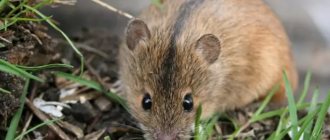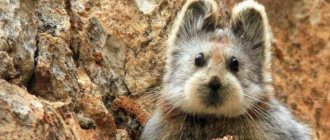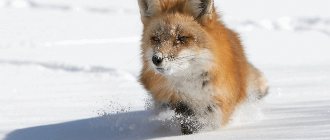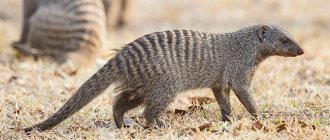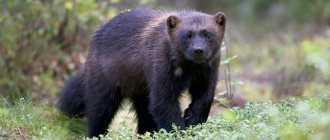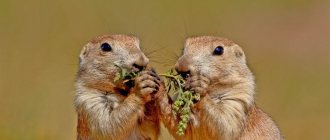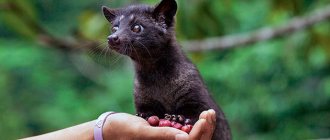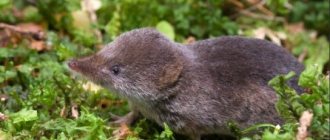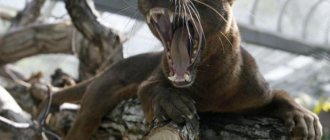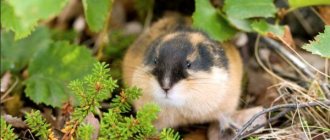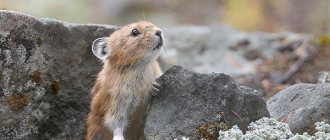Mice are a cosmopolitan mammal species
Mice have a wider distribution throughout the world than any other mammal except humans. Their geographic distribution has been aided by commensal relationships with humans that go back at least 8,000 years .
As commensal animals, house mice live in close proximity to humans and rely on us for food and shelter. They are at home in our homes, barns, outbuildings, warehouses, stores, granaries, fields and farms. But wild individuals are found in almost all habitats - from coastal meadows and dunes to the subalpine zone ( except for the highlands ). Mice also live on a number of sub-Antarctic islands; they are absent only in the Far North and Antarctica.
Photo: Wikipedia
Character and lifestyle
Since mice live in areas with different climates, they need to adapt to different living conditions, and mice have not one, but several ways of adaptation:
- Active throughout the year. These animals make provisions for a rainy day all year round.
- But they can do without supplies if their place of residence is shops, residential buildings or food warehouses;
- Seasonal migrations - closer to winter, mice migrate from their natural habitat to places that are located near human habitation, and in the spring they move back;
- In order to maintain optimal body temperature in hot or cold seasons, the mouse must move too much, and for this it absorbs a lot of food.
The entire life cycle of this rodent depends on body temperature. If a mouse does not move in winter, it will freeze, and if it does not move in summer, during the hot period of the year, then the body will produce excess heat, which can kill the animal.
Therefore, the entire life activity of a mouse consists of the fact that it moves - it gets food for itself, eats, engages in mating games and raises offspring. The main movement in mice begins with the onset of darkness. It is then that they begin to look for food, set up their home, that is, they dig holes, and protect their area from their fellow tribesmen.
Do not think that a tiny mouse is a cowardly creature. In the process of protecting her home, she can attack an animal that is much larger than the mouse itself. If a mouse lives in a place where there is constant twilight, then it is more active, and it has to rest less and in periods.
But if there are people constantly in the habitat of mice, then the mice are not too “shy” - when the room is quiet, they can go out in search of food during the daytime. However, if a mouse is kept as a pet, then it has to adapt to the owner's regime. These animals live in groups, because a single individual will not be able to make large enough reserves, find food and detect danger in time.
True, life in a mouse family is not always cloudless - serious conflicts also occur, which, as a rule, break out due to lack of food. Females are much calmer than males; they even often breed offspring together and jointly raise them.
A mouse is a wild animal and obeys the laws of its family. Its activity also depends on what place a particular animal occupies in this family. It is the leader who determines the periods of wakefulness and rest for his subordinates. In addition, weaker mice try to dig holes and get food for themselves while the head of the family is resting, so as not to catch his eye once again.
The mouse is a typical omnivore
Seeds and grains are the staple foods of house mice, although they are opportunistic omnivores that eat a wide variety of foods. Wild individuals feed on fleshy roots, leaves, stems, berries, insects, caterpillars, spiders, cockroaches, and invertebrate larvae. They do not disdain carrion . Commensal mice feed on any food available to humans, as well as paste, glue, soap and other household items. They especially love foods high in fat, protein and even sugar.
Most of the mice's water needs are met by the moisture in their food. Because they have the ability to concentrate urine, this allows them to colonize semi-desert areas . Mice fed seeds with up to 12% protein can survive without supplemental drinking, but above this protein level they require 3-13 grams of water per day.
Mice have a very high metabolism , so they need to eat 15 to 20 times a day. Because of this frequent need for food, most wild mice make their homes near a food source.
Features and habitat
The mouse is a mammal animal, the order of rodents and the suborder of mice. Rats, by the way, are very similar to mice and belong to the same suborder. The rodent order is one of the most numerous. There is no place on earth that these small animals have not conquered. They can handle any natural area; they are not afraid of either arid areas or snowy places.
They adapt to new living conditions so quickly that they cannot be frightened by any discomfort. Most often, rodents live in burrows, but they find food for themselves on the surface of the earth. Mice, for example, lead only a terrestrial lifestyle, although they have their own burrows.
The photo shows a mouse hole in the grass
The body size of an ordinary mouse is small - its length does not exceed 10 cm, and its weight is only 30 g; its muzzle is small, but its ears and eyes are large. This is understandable - mice constantly need to listen and look closely to see if there is any danger. The tail is not the most beautiful part of this animal’s body.
The fur on it is very sparse, and the length reaches half the length of the body. Moreover, if you look closely, you can see ring-shaped scales. But the mouse itself is not too worried about its beauty, because its entire body is adapted to survive in any conditions, and this is much more important.
The skeleton is strong, reliable and elastic, the color is gray with various shades, that is, exactly the one that will hide the animal from a quick glance, the movements are fast, nimble, dexterous, each part of the body is clearly honed by time for its specific functions and copes with them perfectly , otherwise the animal would not have survived to this day since the Paleocene.
A very interesting feature of the body of this rodent is the structure of the dental system. Mice have molars and two large pairs of incisors, which do not have roots, and because of this they constantly grow by 1 mm per day. So that such teeth do not grow to terrible sizes and simply fit in the mouth, mice are forced to constantly grind them down.
Mice have very interesting vision. It is well developed, because they need to see danger at a far distance. But white mice , that is, those that live as pets, have much weaker vision for the simple reason that they do not need to hide from danger.
It is curious that many mice have color vision, but they do not perceive the full color gamut. For example, these rodents perfectly see yellow and red colors, but they cannot distinguish between blue and green.
The photo shows a white mouse
One mouse produces up to 10 litters per year
Under ideal conditions, one pair of mice and their offspring can produce more than 1,000 pups in a year . Breeding begins at 6-10 weeks of age, and each female can produce 5-10 litters per year. The estrus cycle is 4-6 days, with estrus lasting less than one day. After a short gestation period of about 3 weeks, 3 to 12 pups are born and the cycle begins again 12 to 18 hours after birth.
Photo: Nick Fewings
Newborn mice weigh about 1 gram , are naked except for short whiskers, and their eyes and ears are closed. They are fully covered with fur after 10 days, and by 14 days their eyes and ears are fully open and their incisors have erupted. The young are weaned and begin to leave the nest at the age of 20-23 days, weighing about 6 grams.
While favorable conditions (e.g. nutrition) determine reproduction in commensal populations, wild populations are seasonal breeders and their reproduction is likely influenced by a combination of day length and food availability. Mortality rates before independence were typically 60-70%.
Photo: Phys.org
External characteristics
House mice Rodents have been seen by almost all people living on the planet.
True, everyone’s reaction to this meeting was different. No wonder. Many are even afraid of these nimble creatures, although they can only cause trouble for people in material terms: destroy the harvest, chew wiring and building materials, damage cars and furniture. The house mouse is a mammal with a long tail and an oval body. The size of the animal ranges from 6.5-9.5 cm. Some are interested in the question of how much a house mouse weighs if the tail, covered with sparse short hair and horny scales, makes up almost 60% of the body length. The answer is ambiguous and on average the weight of a rodent is about 12-30 grams.
Mice live in small colonies or family groups
Depending on the prevailing environmental conditions, mice occur alone, in pairs, in small family groups, or in multiple families coexisting at very high densities. Social groups usually consist of a dominant male and several females.
Mice densities range from 10 individuals per square meter in commensal species to 1 individual per 100 square meters in wild species. Under ideal conditions, populations can grow strongly, with numbers exceeding 200,000 individuals per hectare .
What does it look like
Mice of individual species look different, but there are some features that are common to all representatives of this subfamily, for example:
- Large soft ears, oval in shape.
- Big bulging eyes.
- Oblong body.
- Tail bare or covered with sparse hairs.
- Different sizes of front and rear limbs. The front ones are much shorter.
- The anatomy of mice involves long incisors that grow throughout life.
The body length of representatives of the mouse order varies from eight to twelve centimeters in length. The size of some species can reach fifteen centimeters.
Mice are crepuscular animals
Mice are sensitive to bright light, so they are usually nocturnal or crepuscular. Commensal mice adapt to the daily routine of humans. Rodents alternate between sleep and wakefulness for 0.5-1.5 hours. The mouse's activity range is usually limited to an area with an average radius of 3 meters.
Using its superior senses of hearing, smell, taste and touch, the mouse becomes an expert in its range, learning and remembering the location of food, paths and obstacles. When a new object comes into their range, mice are usually not afraid to explore it.
Nutrition
Nutrition of mice Under natural conditions, house mice feed on the seeds of various plants.
They prefer cereals, legumes, and asteraceae, but do not disdain insects and their larvae. They can feed on carrion. If there is access to water, house mice eat plants. Green matter can make up up to a third of their normal diet. House mice should drink up to 3 ml of water per day. If they are exposed to dry climates and eat only dry food, they will die from dehydration within two weeks.
Interesting!
The proximity to humans gives them a clear advantage in the variety of food. They can eat not only their usual food, but also meat, dairy products, and love chocolate. In the absence of the owners of the house, it is not difficult for them to try soap, candles, glue and other things useful to humans.
Mice are used in nearly 75% of animal research procedures
The following are approximate figures for the use of model organisms in laboratory research:
- rats, mice and other rodents, universal laboratory species – 83.3%;
- fish, amphibians, reptiles and birds – 15%;
- sheep, cows, pigs and other large mammals – 1.5%;
- dogs and cats bred for research; the use of stray pets is unacceptable – 0.1%;
- Primates, mainly monkeys and macaques – 0.1%.
Photo: Genetic Engineering and Biotechnology News
Chimpanzees, orangutans and gorillas have not been used in most EU countries for more than 20 years, and in the UK their use is completely banned. Around this time, it was allowed to clone mice . The first cloned mouse, named Cumulina, was born on October 3, 1997 and lived for 2 years and 7 months.
80% of human genes have a comparable gene in mice
The mouse is an excellent model for studying human diseases because its DNA organization and gene expression are similar to those of humans: 80% of human genes have a comparable gene in mice. These rodents have a reproductive and nervous system similar to humans, and they suffer from many human diseases such as cancer, diabetes and even depression. Research in mice has helped us understand both human physiology and the causes and treatments of disease.
Without mice, organ transplantation, IVF, the creation of most vaccines and drugs, and understanding the immune system would be difficult.
How to deal with house mice
Mice in a person's home are a source of unpleasant odors, noise and debris. They leave behind chewed parts and remains of vital activity. In addition, these pests carry various diseases and spoil food.
To protect your home, you need to keep your house and grounds clean. It is believed that the smell of a dog or cat living on the property repels rodents. But as practice shows, this does not always work; mice easily adapt.
But there are animals that enjoy eating mice.
The fight against harmful rodents begins with cleaning the premises. It is necessary to understand where the animals found a secluded place. This will make it clearer how many animals have settled. After this, the method of fight is already determined - sometimes it is enough to set a mousetrap, but in advanced cases more aggressive methods will be required.
Of the 50 ways to combat rodents, everyone will find one that suits them.
Mice are talented athletes
Photo: HomeServe
Mice can jump almost 50 centimeters in height from a standstill and jump from a height of 4 meters without injury. But jumping is not all they are capable of. They are also excellent climbers and swimmers. But the cool thing about them is that they can squeeze through holes the size of a coin. And they are not bad sprinters; they can accelerate to 13 km/h !
Description of the house mouse
House mice are small rodents up to 9 cm in length with a thin tail, which can be equal to half the length of the body. The weight of the pest is up to 30 grams. The species is distributed throughout the world, not found only in the tundra and in regions with low temperatures.
Shades of wild skins can be:
- ashy;
- gray;
- yellowish.
Domesticated ones are found:
- blue;
- gray;
- sandy.
Decorative mice.
Did you know?
- In the wild, mice rarely live longer than 18 months. In captivity, they live on average 2 years, only some laboratory specimens live up to 5 years.
- More than 30 species of mice are known. The most famous species is the common house mouse (Mus musculus).
- Research on mice has been awarded 30 Nobel Prizes.
- Mice are farsighted and colorblind . But at the same time they have excellent hearing with an upper sensitivity threshold of 100 kHz. For comparison, a person perceives sounds with a frequency of up to 20 kHz.
- Whiskers help rodents sense their environment and even detect temperature changes.
- The mouse uses its tail to balance itself when moving along very narrow wires and ropes.
- They cause significant damage by destroying crops and consuming and/or contaminating food intended for human consumption. They have also been implicated in the extinction of native species in the ecosystems they invaded and colonized.
- Mice do not sweat and cannot vomit. This is one of the reasons why the poison is so effective in killing these creatures.
- The length of a mouse's tail accounts for over 60% of their total body length.
- An adult mouse has a heart rate of 632 beats per minute (plus or minus 51 beats per minute). The human heart beats only 60 to 100 beats per minute.
- Mice groom themselves several times a day and are less likely than dogs or cats to carry parasites and viruses.
- In the city of Myshkin (Yaroslavl region), the world's only Mouse Museum , all exhibits of which are dedicated to mice.
- Male mice perform ultrasonic serenades for females, which is why they have been added to the short list of singing mammals that only includes bats, whales and humans!
- People have eaten mice since prehistoric times and are still served as a delicacy in eastern Zambia and northern Malawi, where they are a seasonal source of protein. They are also hunted by cats, wild dogs, mongooses, lizards, foxes, birds of prey and snakes.
- The mouse is a shamanic symbol of wisdom, mindfulness, discovery and organization.
How are mice different from other rodents?
If we conduct a detailed description of mice, it is important to note that they have excellent hearing, allowing them to pick up sounds of various tones. To do this, they use ears that are rounded in shape.
On the small pointed muzzle you can notice the presence of antennae called vibrissae. Thanks to this important organ, mice are able to navigate perfectly, even in the dark. However, they do not have pouches behind their cheeks.
Most species of mice do not like to climb trees, however, they easily move on the basis of grass stems growing in meadows. And also for this they use reeds or small branches of bushes.Among them, the smallest individual was identified; it was named “baby”, since it has a body size of only 5 cm.
